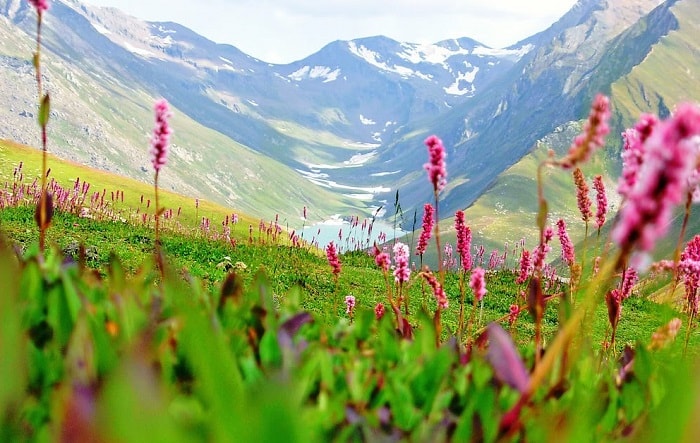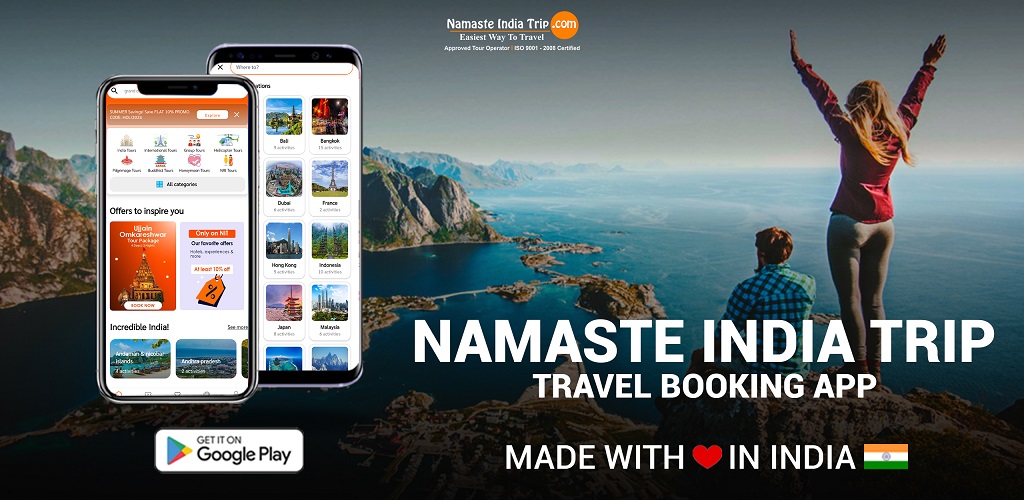Valley of Flowers perched amid the snowy peaks of Uttarakhand mountain ranges is a region of ethereal beauty. The colorful Himalayan flowers growing there plus many other rare vegetations and animal life found there pull travel thirsty people to the region every year. To know all details about ‘Valley of Flowers’ read on:
The ‘Valley of Flowers’ is a region that lures thousands of passionate nature lovers and adventure lovers every year. They all trek to this land of divine beauty perched in the lofty peaks of West Himalayas ignoring the difficult journey across the rigorous terrain only to drink its beauty to the lees. The region got its name from the numerous Alpine flowers that bloom in the vale, just with the melting away of the snow. It appears, as it were, the valley that was lying dry and drab under the cold sheets of ice so long has suddenly awakened to youthful beauty, presenting a real riot of colors! To get to view such a sight of rare natural beauty is indeed a lifetime experience for any traveler and so it’s worthwhile to set out on a trip of this enchanting valley.

The region was unchartered and not even known for all the natural gems hidden in it before the botanist Frank Smith discovered it and was spellbound by its enchanting floral view. In 1982, Valley of Flowers was announced as World Heritage Site plus National Park. UNESCO recognized this vale as ‘Heritage’ because it was discovered that some very vital medicinal herbs grow naturally in the Valley of Flowers. We can relate this fact to the myths easily. According to Hindu mythology, Hanuman Ji picked the Sanjeevani Booti from this very region to save the life of Lakshmana who received fatal wounds at a battlefield.
The flowers that bloom in the ‘Valley of Flowers’ belong to some of the rarest species and the most renowned ones are Cobra Lily, Brahma Kapal, Blue Poppy. It is indeed wondrous to find such a floral valley at a height of some 3600 meters from sea level. So flower lovers and botanists leave no stone unturned to reach the Valley of Flowers and witness its panoramic floral splendor.
How to Reach
The Valley of Flowers falls in Chamoli district of Uttarakhand. To reach Valley of Flowers, you have to first reach Govindghat (1828meters from sea level). From Govindghat you need to first trek to Ghangaria, a difficult 13 km of trek over a steep enough terrain. From Ghangaria onwards the remaining part of the trek route becomes less difficult comparatively and you need to cover only 4km to reach Valley of Flowers after Ghangaria. From Delhi you need to cover 505 kms to reach Govindghat. Well-developed road transports like buses, taxis are available to make enthusiasts reach Govindghat comfortably and then your 17 kms of the unique trek starts. The location of Govindghat on NH58 makes it easily reachable by road transport. It is connected via road transport to all key Uttarakhand destinations such as Ukhimath, Rishikesh, Karnaprayag, Rudraprayag, and Chamoli. If you wish to come by flight, then you can fly from Delhi airport to land at the Jolly Grant Airport and thereafter avail road transport to reach Govindghat. If you wish to know about the rail route, then you must know that you have Rishikesh by train in order to reach Govind Ghat because that’s the rail station falling nearest to Valley of Flowers. From Rishikesh, you can access the motorable route to Govindghat, the point from where your memorable trek to the valley of flowers commences.
[ Click Here to Enquiry for Uttarakhand Tours ]
When to Visit
As you can understand the region is a high altitude region. Visiting it in the winters is not only risky but also impossible. The travel season for Valley of Flowers is between June-September as for the other parts of the year, the region remains inaccessible due to heavy snowing.
Sightseeing
Enroute your Trek to Valley of Flowers, you can visit some other significant attractions like Hemkund Sahib, Ghangaria, and Nanda Devi National Park.
Hemkund Sahib is a lake situated at an altitude of some 4329 meters from sea level. Myths hold that Guru Govind Singh Ji went into deep spiritual meditation at the Hemkund Sahib. The lake is adjoined by a Gurdwara characterized by a unique star shape. ‘Hem Kund’ stands for ‘Lake of Snow’ and indeed the pellucid water of this lake, set in the midst of the snow clad mountains, is icy cold. Nearby is a temple too; i.e. the famed Lakshman temple where Lord Rama’s brother, Lakshmana is the residing deity.
Ghangaria, perched at height of 3050 meters from sea level, is a picture-perfect hamlet and the last habitat of humans that falls on the course of your trek. The sprawling meadows, blue sky, snow-clad peaks around indeed create a blessed ambiance for any passionate nature lover.
For wildlife enthusiasts, Nanda Devi National park will indeed prove a thrilling visit. The renowned peak of Nanda Devi towers over this sprawling National park which was declared as World Heritage site in the year 1988 by UNESCO. The area covered by the park is 630.30 sq km. This park falls within the Biographical zone of the Himalayas and includes some rare species of fauna like snow leopard, blue sheep, Asiatic black bear, Himalayan musk deer, Brown bear, Serow, Goral, Himalayan black bear etc. The abundance of flora in the park too leaves one wonder-struck. You get to see wide variety of Rhododendrons here plus plant species like Juniper, Birch, Fir. Visit between April-October and have a real fun time exploring the gifts Nature has endowed the park with.
If you wish to meditate on the beauteous sights of ethereal Nature, come to the Banks of Pushpawati River which courses through the beautiful floral valley and then confluences with Rishi Ganga. Its considered a sacred confluence by the many pious souls. For Nature lovers, it is a privilege to watch the cascading river making its way with a gurgling sound across the Valley of Flowers.
Fairs & Festivals
There is no fair or festival taking place directly on the Valley of Flowers. However in the nearby regions many fairs and festivals are celebrated with great pomp and grandeur which you can attend. The Chamoli district where Valley of Flowers falls is notable for Fairs like Gaucher Fair, Fairs held on the occasion of Nag Panchami, Holi, Ram Navami, Bishwat Sankranti, Butter Festival, and Nanda Devi Raj Jat. If you schedule your visit to the Valley of Flowers with time period when these fairs are held, you can, of course, enjoy a visit to these fairs as well.
Accommodation
There are Government rest houses plus hotels with decent accommodation facilities like 24/7 hot water supply, food and lodging, laundry etc at Ghangaria. So regarding accommodation, you need not worry.
Cuisine
At Ghangaria, there are many Dhabhas and hotels serving local food. You can sample some of the mouth-water regional cuisines of Uttaranchal therein. For your trek route it is advisable to carry with you dry fruits and nuts that would boost your energy level and provide warmth to your body in a really cold ambiance.
Shopping:
The region is not for shopping. So forget about splurging money on souvenirs and just focus on the bounties of Nature out there. It is truly a fairyland atop the snowcapped mountains and it’s time for you to meditate on nothing else other than its splendid beauty.
So now you know all about Valley of Flowers. Hurry up and plan for a trip to this wonderful vale.

 Call
Call WhatsApp
WhatsApp Enquiry
Enquiry